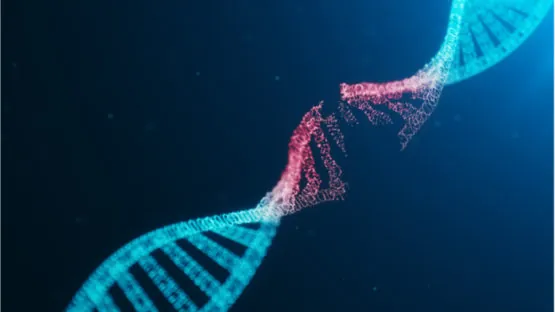Research further illuminating the mechanisms of impaired DNA damage repair associated with aging has recently been published in the journal Aging.
DNA damage repair is reduced as we age
While we have multiple mechanisms for repairing genomic damage, one type of damage, double-strand breaks, is particularly dangerous to cells. When both strands of the DNA double helix are broken, the broken ends can link together, preventing it from being repaired. The two main repair mechanisms for double-strand breaks are non-homologous end joining (NHEJ) and homologous recombination (HR). Both of these processes are highly regulated and while NHEJ occurs during all parts of the cell division cycle, HR occurs primarily from the mid-S to the G2 phase.
This study, produced by the Universitat Autònoma de Barcelona in Spain, has investigated these two pathways and their changes with age in mammary epithelial cells. [1] First, the researchers compared cells from aged (greater than 60 years) and young (less than 27 years) donors. The aged cells had significantly less NHEJ activity and HR activity than young donors, suggesting that both repair mechanisms are impaired with age.
Investigating the cause of reduced DNA repair
Next, the authors looked at the marker 53BP1, which localizes to double-strand breaks to initiate the NHEJ repair response. After DNA damage was induced by exposing the cells to radiation, less 53BP1 was found at double-strand breaks in the aged donor cells. This specifically implicates 53BP1 in the age-related decline of NHEJ. A different marker, BRCA1, plays a similar role during the HR repair response. No differences in BRCA1 were seen between young and aged cells in the G2 phase, despite overall HR activity being reduced. This apparent contradiction was explained by RAD51, a core protein further downstream in the process from BRCA1, which was found to be reduced in the aged cells.
The researchers then investigated what was causing the decrease in 53BP1 recruitment to double-strand breaks. Several lines of investigation looking into the synthesis and maintenance of these two proteins showed no differences between the young and aged cells. In other words, 53BP1 and RAD51 were present in similar amounts at different ages, suggesting that the problem instead lies with their recruitment to the sites of double-strand breaks. Several epigenetic explanations were investigated before decreased expression of SETD8 was finally identified as the most likely culprit.
Interestingly, it was also found that BRCA1 was localizing to double-strand breaks even in G1 cells. Cells in the G1 phase of the cell cycle are usually limited to the 53BP1/NHEJ repair response. However, the impaired localization of 53BP1 allowed BRCA1 to localize to G1 cells instead. Despite the localization of BRCA, these double-strand breaks were not able to be repaired by the HR process as evidenced by an absence of the downstream RAD51 protein.
In summary, we propose that 53BP1 deficient recruitment to DSBs is a hallmark of age, and we present a model for a DSB repair pathway choice in HMECs from aged women (Figure 5). Upon induction of DSBs in YD cells, 53BP1 is recruited in the G1 phase and promotes c-NHEJ. In contrast, AD cells fail to recruit 53BP1 to DSBs efficiently, allowing their ectopic occupancy by BRCA1, which is followed by CtIP-mediated DNA-end resection. If resection is extensive enough, single-stranded fragments are coated by RPA while awaiting ligation. Because the c-NHEJ pathway is inhibited by extensive DNA-end resection of breaks and HR cannot be launched in G1, we speculate two possible outcomes for these DSBs: they might remain extensively processed and unrepaired until the cells progress to S phase and HR can be fully launched in the presence of a DNA template or, otherwise, they become substrates for alternative and highly mutagenic backup mechanisms of DNA repair, such as Alt-EJ repair. The present work evidences the connection between genome integrity and aging. Future efforts addressing the exact mechanism to counteract BRCA1/CtIP activity during the G1 phase in cells from older individuals could be of extreme interest, as they would allow the restoration of DNA repair fidelity during aging and prevent a rise in genomic instability in older individuals.
Conclusion
Several questions remain regarding the application of these findings for broader purposes. These findings were specific to mammary epithelial cells in 2D culture, isolated from 11 female donors, with double-strand breaks induced by radiation. It is unknown whether the same results would have been found in vivo, in different cell types, in men, in the broader population, or after other causes of DNA damage.
However, this study is an excellent example of continuing to go upstream to find underlying causes for age-related impairments. The mechanisms outlined here could help explain the increase in defective DNA repair seen in older cells, which is known to lead to negative effects, including cellular death, senescence, and cancer. While not directly resulting in any treatment for genomic instability, basic research like this study is the foundation on which translational work is built which may lead to healthy longevity.
Literature[1] Anglada, T., Genescà, A., Martín, M. (2020). Age-associated deficient recruitment of 53BP1 in G1 cells directs DNA double-strand break repair to BRCA1/CtIP-mediated DNA-end resection. Aging (Albany NY), 12(24); 24872-24893. https://doi.org/10.18632/aging.202321




